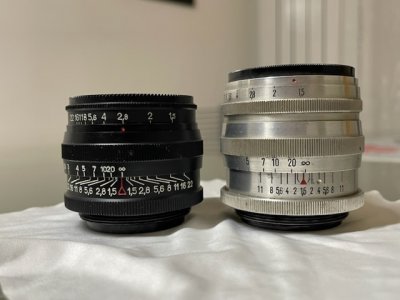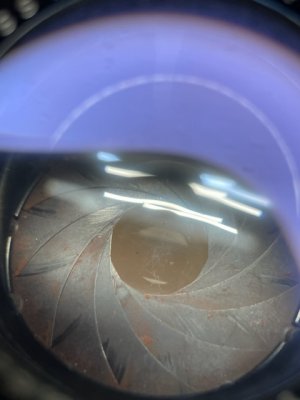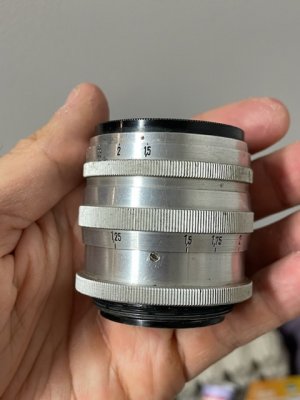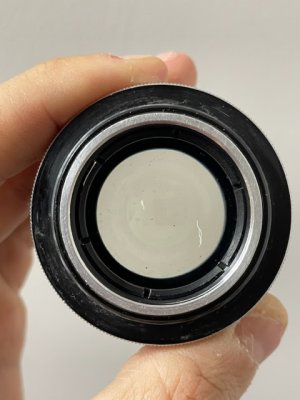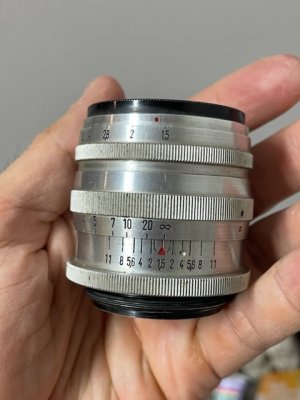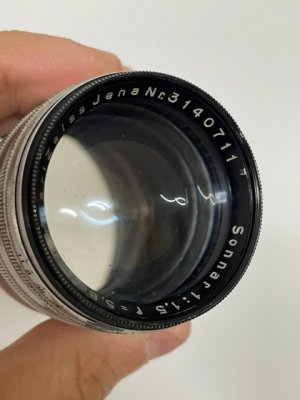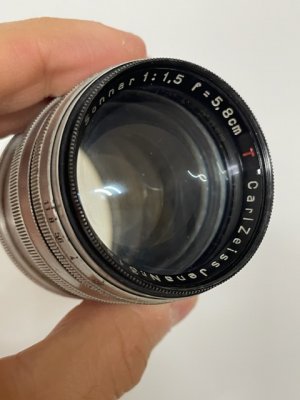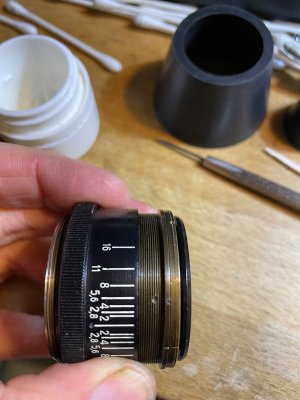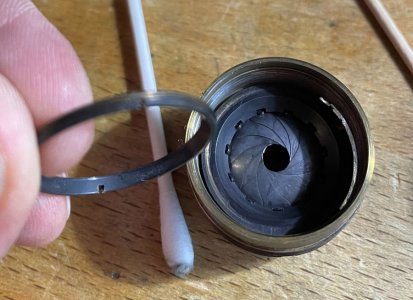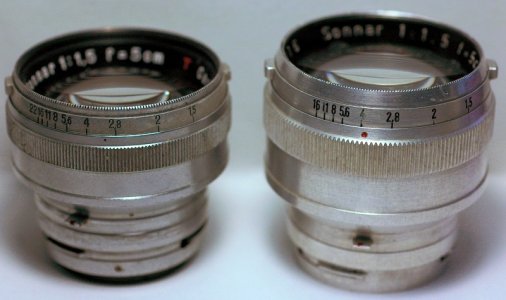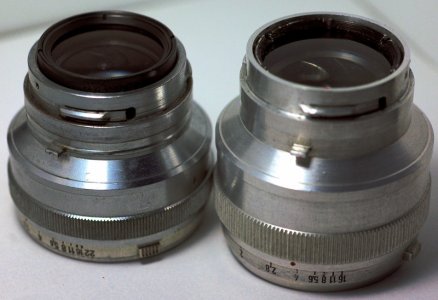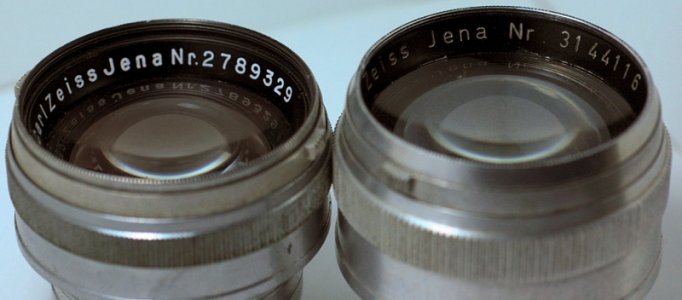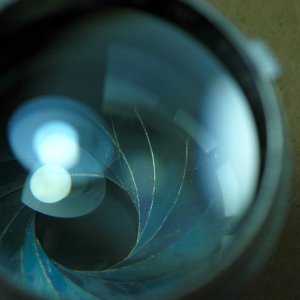Continuing the "Information you will not be able to get anywhere else!" thread... (thanks Brian!)
Another post, another Biotar. This time the 5.8cm f/2 - Post war black version. And just on cue as
@S.H. talked about the very factory that in all likelihood made this. It's not in the Thiele. The original finished mount was supposed to be Practiflex. Lot of 1000. Practicaflex mount pitch is M42, which to my understanding later became the sort of de-facto standard for single lens reflex lenses for a good while.


But, I digress, as you can see it's not in M42 mount (anymore) this is L39 or LTM if you may. Of note are the lovely patina (it's been used - we will get to why that is important) and the two big screws. We have seen this style of construction before. I think I posted it in this very sub-forum. Namely the re-manufactured 8.5cm f/2 Sonnar - also into LTM mount. For a laugh I (carefully!) interchanged the screws between the two. Perfect fit. Smoking gun? Probably not. But since screws back then were usually hand-made I reckon that's as good as a confirmation we are going to get 80 years later.


Anyway - the Biotar came to me - relatively (for its rarity) cheaply based on the fact that both the rangefinder AND the lens were out of whack, not just to each other but also independently. (The RF cam would not register infinity, the also failed to hit infinity, but moved at a different clip to the RF.)
Now looking at the other works this crew had done (the 5.8cm Sonnar, the 8.5cm Sonnar and ... I think the 5cm f/2 hourglass one I have ...) their work is usually the opposite of slipshod and the lenses were usually well calibrated. This and the aforementioned patina led me to assume that this lens rather either had been dropped (a bad scenario) or more likely a failed service attempt.
Knowing how important it is to thread the Helicals together JUST right in these Zeiss lenses plus the construction of the RF cam - which is unbeknownst to most on the internet (until now I would say) is adjustable(!) - I decided to take a gamble on it. When I got it the aperture was clean inside and the focus moved remarkably smoothly, just not correctly as I quickly confirmed.
To take this lens apart you should NOT touch the two big screws. Start from the aperture ring. Pull that off. Then the focus ring. Carefully. Since it also has the detents for the focus stops in it you do not want to warp it. Lastly the depth of field scale ring comes off. Underneath the depth of field scale ring are three more slotted screws. They hold in the entire lens and assembly.
While undoing these absolutely apply gentle but firm pressure on the lens head downwards - the whole thing is under spring tension - the return spring for the focus cam namely.


Pictured above (left) are the lens head (with the focus mechanism in place) and it's mate (right) which contains the mount, a spring and the focus cam, held in place by those two big screws. I am holding the rangefinder mechanism to it in the right picture. The mechanism is a simple sloped cam riding on a fine pitch helical. Brass on brass. A chromed brass rod rides in this slope and pushes on the focus cam. This is where our first issue was.

Circled in red is a headless grub screw. it links the chromed brass rod to the spring-driven rangefinder cam/tongue. You can undo this screw and either push the rod in (less deflection = moving the RF closer) or pull it out (more deflection from the sloped cam = RF moves toward (and past) infinity). These are minuscule adjustments and they are quite fiddly. But it is totally do-able. I had it on my trusty Canon RF for this purpose.


Right picture shows the lens head and sloped cam well. On the bottom of the right picture you can see the screw which is akin to the screws in the Russian/Sonnar lenses and basically makes sure that the lens head does not rotate as the helical (left picture) drives the lens head in and out. This construction along with the unprecedented access to Zeiss prototypes and raw materials makes me believe that some of these people were ex-Zeiss machinists almost certainly.
The second issue (lens not reaching infinity) was similarly a repair mistake. Likely the previous repairer had not removed the brass screw circled in red. Which allows you to more fully mate the black helical to the brass (RF cam driver) helical. It was off by one revolution. Since the black helical (as you can see on the right towards my hands) has coarse inner threads this makes quite a difference in focus! You can also see this mistake by the scratched manufacture marks not lining up as well.
Being off by one revolution meant of course that the index marks all line up - the lens looks "right" but will not work properly. My generic piece of advice is for Zeiss and Russian lenses to always find the helical start that lets you mate the two helical pieces to the maximum possible extent and then slowly back them up so you can get the screws in. In 90% of the cases this is the correct position.The other 10%? Lots of bad words get said and a lot of trial and error, I am afraid. Luckily this lens was of the 90%.
Sadly I have no optical block disassembly pictures as the early black Biotar 5.8cm/2 lenses are
famously fiddly (Japanese w Google Translate to English) and since the previous repairer had at least done a good job with the aperture and glass I chose not to tempt fate this time. You can check the link for that info, with plenty of pictures to boot!
It is all back together and works well now. I hope you find this information useful.
I apologize for the middling quality of the pictures this time - I tried to make it up by explaining a bit more verbosely - I took these as personal memos just in case I had to put the lens back together as it was in case I could not resolve the issue, only later I realized the value of this information.



















